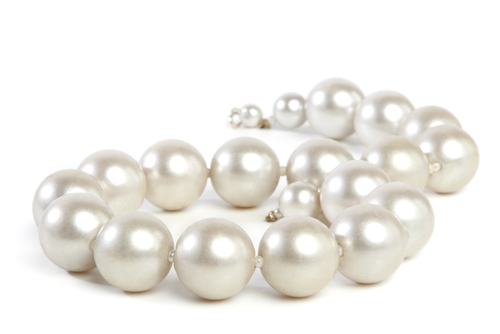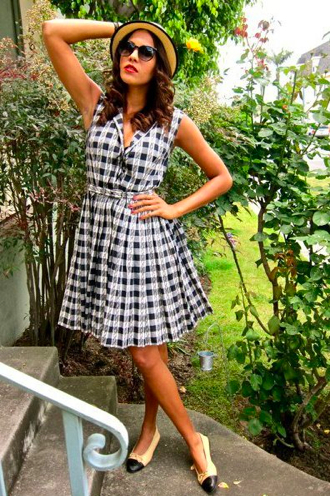
Quality:
Luster: Luster is the quality of light a pearl reflects… both from its surface glow and its inner light. The luster of a good quality pearls is sharp and bright. You should be able to see your reflection clearly on the surface of a pearl. Any pearl that appears too white, dull or chalky is of low quality.
Surface Perfection: Subtle blemishes and tiny marks are part of a pearl’s natural texture and proof of its genuine origin. These blemishes result from sea particles that drift into the oyster and brush against the pearl as it forms. The cleaner the surface of the pearl, the more valuable it is. Notice that the highest quality pearls have sharp, mirror like reflection.
Shape of a Pearl: A perfectly round pearl is rare and of course the most valuable. The other many shapes available are: Round, Off Round, Button, Drop, Baroque and Ringed.
Color of a Pearl: Pearls vary widely in color, based on the type of oyster that produces them. While color choice is a matter of personal preference, always look for rich color that is evenly distributed throughout the pearl. The rarer the shade, the more valuable the pearl. Colors range from silver, ivory, rose, silver rose, copper, peacock, green, dark silver and light silver. White and pink rosé are among the most popular colors, while peacock green and gold are among the rarest.
Size: While size does not affect the quality of cultured pearls, it does affect the price. Large pearls are more difficult to cultivate, making them more expensive. Pears are measured by their diameter in millimeters. The classic average pearl generally ranges between 6.5 and 7.0 mm.
Orgin:
Akoya Cultured Pearls: Prized for their brilliant luster and rich color, Akoya pearls are a traditional symbol of elegance and beauty. Produced by Japan’s Akoya oysters, they are the most popular of all pearl types. Depending on the size of the mother oyster, they grow from 3-10mm. Colors range from white, cream and pink to light green, blue and silver.
Black South Sea Cultured Pearls: The breathtaking color of these naturally black pearls is produced by black-lipped oysters in the waters off Tahiti and Okinawa. Sizes begin at 8mm, in round, oval, teardrop or unique baroque shapes. While characterized as black, the rich, dark colors actually range from slate grey, silver and pistachio to peacock green and midnight black with overtones of green, rosé or blue.
South Sea White Cultured Pearls: The magnificent, satiny luster of these fantastic white pearls is produced by the silver-lipped South Sea oyster. Their subdued opalescent appearance subtly changes under different light conditions, making them a constant marvel to behold. Harvested in sizes from 9mm up, their shapes range from round, oval or teardrop to free-form baroque.
South Sea Golden Cultured Pearls: These opulent pearls are produced by the golden-lipped oyster. Their warm, natural golden color is said to be rarer than gold itself. The color palette ranges from light champagne to a very rare, deep gold. This oyster species can also produce richly luminescent white pearls, but the deeper golden colors are the most coveted of all pearls. Harvested in sizes of 9mm and up, in round, oval, teardrop or beautiful baroque shapes.
Freshwater Cultured Pearls: Produced mostly in the lakes and rivers of China, Freshwater pearls are cultured in a mussel rather than an oyster. Often small in size, as many as ten to fourteen Freshwater pearls can be cultured in one mussel. Perfectly round Freshwater pearls are extremely rare.
Conch Pearls: These natural pearls are harvested from the Queen conch, a large marine snail with a heavy, lustrous shell which lives in the Caribbean and the Gulf of Mexico. The highest-quality examples of Conch pearls are characterized by a distinctive “flame structure” that gives the appearance of a fire burning on the surface.
Style:
Choosing Length: A few simple considerations will help you pick the right strand length for your personal style… and lifestyle. Women in their 20s often start their collection with shorter strands and smaller pearls which nestle near the base of the throat. Consider the Choker and Princess lengths to optimize your youthful fashion look. Women in their 30s and beyond may prefer the fashion impact of longer lengths of pearl necklaces and larger pearls, which add drama while beautifully illuminating the face. Opera and Rope are enjoyed for their versatility, as they can be doubled or tripled around the neck.
- 12-13″ = Collar: pearl collars usually made up of three or more strands and lie snugly in the middle of the neck.
- 14 – 16″ = Choker: This classic and versatile piece is appropriate with everything from casual to formal evening wear and compliments almost any neckline
- 17″-19″ = Princess Necklace: The classic length for pearl necklaces and also the most common length for pearl necklaces, it is well suited for high or plunging necklines
- 22- 24 = Matinee and 30-32 = Opera: it can be worn in a single strand or doubled to create a two strand choker. It can also be knotted at the neckline or above the bust to create a vintage look. Traditionally this length is worn with evening wear.
- 37″ and Longer = The Pearl Rope: The luxurious length can be broken down into different necklace and bracelet combinations. It can e doubled or tripled to create a multi strand pearl choker.
Care:
Avoid: Cosmetics, sun block, perfume, and hair spray all contain chemicals that can dramatically dull the luster of a pearl. The natural acids contained in body oils and perspiration can also damage pearls in the same way. It is best to put your pearls on at least 30-minutes after applying any personal care products, and to take your pearls off before getting ready for bed. A good rule of thumb to remember is that pearls should be the last things to put on and the first things to take off.
Protect: Keep pearls away from other hard jewelry made from gold or silver to keep it free from scratches. Your pearls jewelry is best kept in a soft cloth pouch or fabric lined jewelry box. After wearing them you can wipe them with a damp cloth to keep them clean from harmful build up.
Re-stringing: If you wear your pearls often, they should be restrung every year to avoid the strand from breaking. Pearls can be restrung with silk or nylon string and should be knotted between each pearl to prevent rubbing.
Cleaning: Try The Pearl Doctor for an organic, eco-friendly way to clean your pearls at home. -Mikimoto.com/PearlParadise.com








0 comments ↓
There are no comments yet...Kick things off by filling out the form below.
Leave a Comment